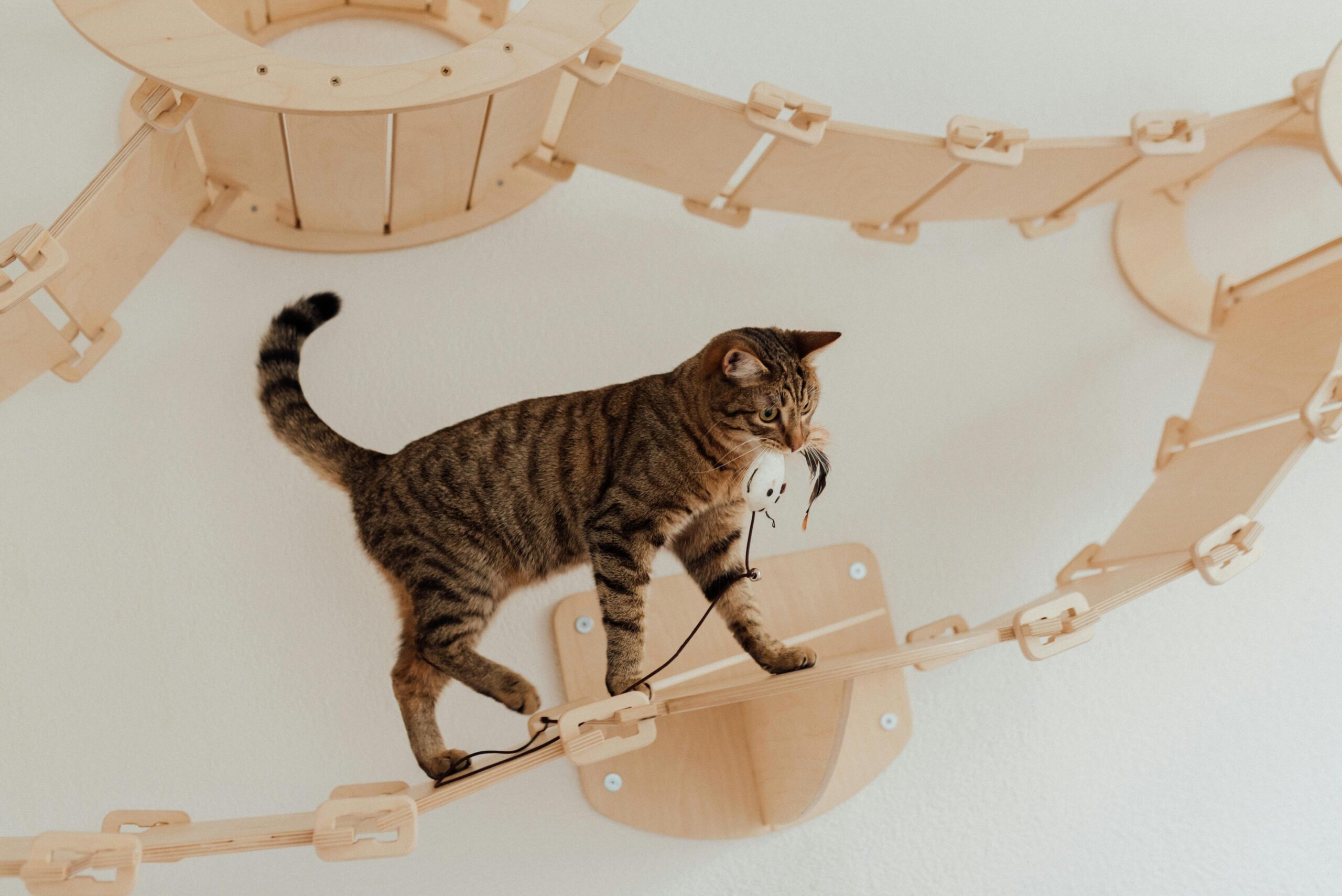You’ve lovingly set up a cosy space for your cat—cat trees, plush beds, scratch posts—and yet they’re still sinking their teeth into your phone charger or gnawing on your dining table legs. Sound familiar? If your cat has developed a habit of chewing cords, shoes, wooden furniture, or other household items, you’re not alone. While it might seem like a quirky phase, this kind of destructive behaviour can be dangerous and costly if left unaddressed.
In this guide, we’ll explore why cats chew, what it means behaviourally, and how to use training toys, positive reinforcement, and behavioural training to curb the habit safely. Whether you’re dealing with a curious kitten or a bored adult cat, these strategies will help keep your belongings—and your feline—safe.
Why Do Cats Chew?
Cats aren’t natural chewers like dogs, so when they start biting into your furniture or cords, it’s often a sign of something deeper. Here are some common reasons:
- Boredom or lack of stimulation
- Teething in kittens
- Stress or anxiety
- Nutritional deficiencies
- Medical conditions (such as dental issues or pica)
- Attention-seeking behaviour
- Curiosity about new textures
Understanding the root cause helps you apply the right behavioural training technique.
Step 1: Rule Out Medical Issues
Before diving into training, take your cat to the vet to rule out medical causes. Chewing may indicate dental discomfort, nausea, or an underlying condition like pica (a disorder that causes animals to eat non-food items). Once medical issues are off the table, you can focus on behaviour-based solutions.
Step 2: Pet-Proofing Your Home
An immediate step is to prevent access to dangerous items like power cords and wires. Pet-proofing your home is crucial for safety, especially if your cat is home alone for long stretches.
Tips:
- Cover cords with protective sleeves or PVC tubing
- Use double-sided tape or bitter-tasting sprays on furniture legs
- Keep tempting objects like rubber bands, shoelaces, or charging cables out of reach
- Secure loose cords with cord organisers or cable management boxes
By reducing temptation, you eliminate opportunities for bad habits to form.
Step 3: Redirect the Behaviour with Toys and Training
Now that you’ve made the environment safer, it’s time to redirect behaviour toward appropriate outlets using training toys, puzzle toys, and interactive toys.
Great options include:
- Chew-friendly cat toys with different textures
- Puzzle toys that dispense food or treats to encourage focus and mental stimulation
- Interactive toys like wand toys or motion-activated mice to burn excess energy
Provide a variety of textures—rubber, sisal, cardboard—to satisfy their curiosity. Make playtime part of your daily routine to help prevent boredom-based chewing.
Step 4: Use Positive Reinforcement and Clicker Training
Cats respond best to positive reinforcement. Instead of scolding them for chewing the wrong item, reward them when they choose an appropriate toy. This is where clicker training comes in handy.
How to use clicker training for chewing issues:
- When your cat interacts with a chew-safe toy instead of cords, click the device.
- Immediately offer a training treat.
- Repeat until your cat starts seeking out toys instead of furniture.
Consistency is key. Rewarding good choices helps build long-term habits, especially if your cat is still in the kitten training phase.
Step 5: Provide Enrichment and Exercise
A tired cat is a well-behaved cat. Destructive behaviour, like chewing, often stems from under-stimulation. Aim for two or more structured play sessions per day.
Ideas:
- Simulate hunting using wand toys or laser pointers (stalk, chase, pounce, reward)
- Offer different puzzle toys for mental enrichment
- Introduce cat-safe climbing spaces like wall shelves or tall towers
You can even explore leash training for safe outdoor adventures. The more variety and activity your cat gets, the less they’ll be interested in cords or furniture.
Step 6: Identify and Reduce Stress Triggers
Stress and anxiety can also lead to chewing. Big changes—like moving homes, a new baby, or another pet—can cause tension.
Signs of stress-related chewing:
- Excessive licking or grooming
- Hiding or vocalising more than usual
- Litter box issues or sudden aggression
To reduce stress:
- Stick to a predictable daily routine
- Provide calming spaces with soft bedding and hiding spots
- Use pheromone diffusers like Feliway
- Spend quiet bonding time with your cat
This kind of aggression management through environment and routine can reduce all kinds of destructive behaviour, including biting, scratching, and chewing.
Step 7: Redirect Chewing with Training Treats
When your cat is caught in the act of chewing a forbidden object, avoid punishment. Instead:
- Calmly say “no” in a firm but gentle voice.
- Offer a chew-safe toy immediately.
- If they accept the toy, reward them with a training treat.
Doing this consistently builds a strong association between acceptable chewing and positive outcomes. It’s one of the easiest and most effective behavioural training tactics.
Step 8: Understand the Role of Age and Energy
Younger cats and kittens are far more prone to chewing due to teething and curiosity. In this case, early kitten training is vital. Start with soft chew toys and reinforce good habits with clicker training.
Older cats may develop chewing habits from lack of stimulation or cognitive decline. In these cases, try rotating toys, creating new climbing opportunities, or even introducing new training toys to re-engage their minds.
Step 9: When to Use Training Collars or Other Tools
Training collars can be helpful in specific cases—but never as punishment. A breakaway collar with a motion-activated deterrent may help discourage cats from entering certain areas. However, use these only in combination with enrichment, training, and redirection.
More effective long-term solutions often include:
- Clickers for reinforcement timing
- Training treats for rewards
- Puzzle toys to curb boredom
- Routine play to satisfy instincts
The best tools are the ones that create a bond of trust, not fear.
Step 10: Seek Professional Support if Needed
If your cat’s chewing is extreme, compulsive, or causing injury (to themselves or others), it’s time to speak with your vet or a feline behaviourist. They can:
- Rule out nutritional or medical issues
- Create a tailored behavioural training plan
- Recommend environmental changes
- Offer advice on multi-cat household dynamics
A professional’s input can be especially valuable in cases where chewing overlaps with other concerns like aggression, biting, litter box training, or scratching.
Final Thoughts
While a chewing cat may seem like a mischievous troublemaker, they’re often just curious, bored, or anxious. With a little patience and a lot of love, you can guide them away from cords and furniture toward healthier habits.
The key is to redirect behaviour using training toys, positive reinforcement, and environmental enrichment. Make playtime exciting, offer engaging textures, and reinforce calm behaviour with praise and training treats.
Your cat’s instincts aren’t the enemy—they just need the right outlet. With consistency, patience, and a dash of creativity, you’ll help them thrive in a chew-free, happy home.






